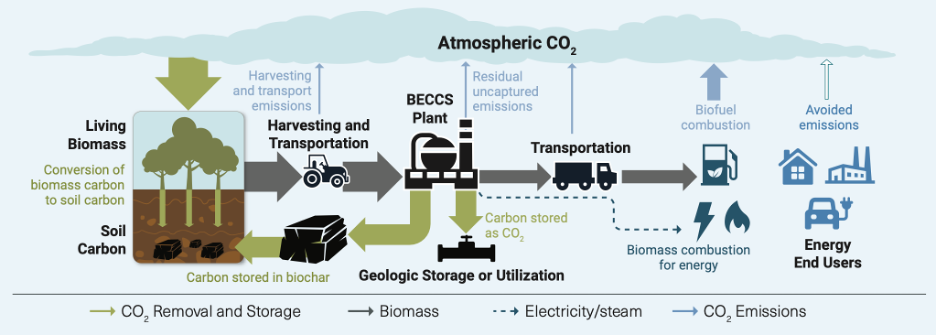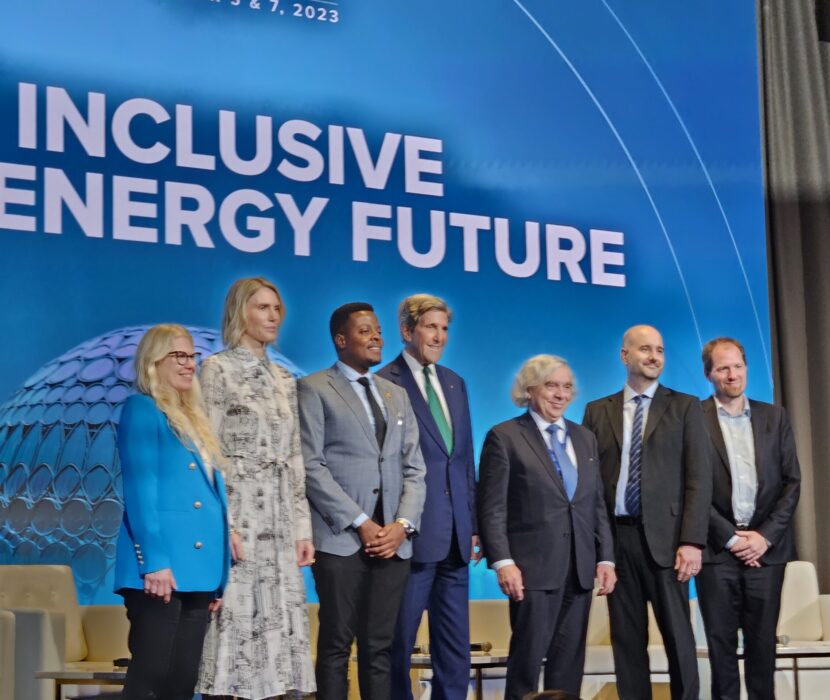The Energy Futures Initiative released a literature review on bioenergy with carbon capture and storage. It is the first installment in a project to assess the potential of this set of technologies as a key carbon removal method.

To halt the effects of climate change, we need to not only stop adding new carbon dioxide to the atmosphere — we need to remove some of what is already there. Carbon removal is needed in some form, as reiterated in the Intergovernmental Panel on Climate Change’s latest report earlier this year. Removing carbon shouldn’t be a substitute for building out clean energy industries, but we will need it to offset some emissions in sectors that are very difficult-to-decarbonize, such as heavy industry and agriculture. Over the long term, we will also need carbon removal to lower the climate impacts of emissions we have already released.
But the popular carbon removal technology — direct air capture (technology that captures carbon dioxide directly from the air) — has far to go to become a commercial reality. Climate models use a technology called bioenergy with carbon capture and storage (also known as BECCS) to project the role of carbon removal in decarbonization. Although we will need all solutions, including direct air capture and natural solutions such as planting trees, bioenergy with carbon capture and storage is used in climate modeling because it could be the technology with the lowest near-term costs and a greater ability to scale. Still, the potential impact of bioenergy with carbon capture is unclear and varies widely — with some sources projecting it has the potential to abate up to 31% of net greenhouse gas (GHG) emissions globally and others estimating it could be no more than 3% (page 8). The Energy Futures Initiative (EFI) has set out on a project to clarify this technology’s potential contribution to reaching net-zero GHG emissions by mid-century and to develop a comprehensive national strategy and policy roadmap, beginning with a literature review of the industry landscape.
How can bioenergy with carbon capture be a net-negative technology? If you outfit a natural gas power plant with carbon capture and storage technology, essentially all the carbon emitted from the natural gas combustion can be captured and stored in the earth — making the electricity zero emissions. However, if you outfit carbon capture and storage technology to a power plant that produces electricity from biomass (plant matter, such as wood pellets), the result can be net-negative — resulting in carbon removal.

This is because a biomass power plant is already net-zero in terms of emissions from the biomass itself. Burning wood pellets does release CO2 emissions, but that emitted carbon does not increase carbon in the atmosphere the way natural gas and coal do. This is because rather than releasing carbon from fossil fuel deposits deep within the earth, the wood’s carbon comes from the air already — it was captured relatively recently by photosynthesis as the tree grew. Although the process of harvesting the wood, producing the wood pellets, and burning them in the power plant adds a carbon footprint, the burning of the wood itself does not contribute to climate change because it does not increase levels of carbon in the atmosphere — it simply returns carbon to the atmosphere in a closed cycle. This means that using carbon capture and storage technology to store that carbon permanently has the potential to remove it from the atmosphere.
All current bioenergy with carbon capture and storage projects capture CO2 gas and store it deep underground, where it cannot contribute to climate change. Some future projects could convert the carbon into a biomass-derived charcoal called biochar and then use it to improve soil and crop fertility, reducing the need for synthetic fertilizer. Carbon stored as biochar can stay in the ground for centuries, and there is already a small market for it.
Bioenergy with carbon capture and storage is the most near-term carbon removal technology because it builds off two already commercial bioenergy industries: biomass power and biofuel (the U.S. ethanol industry). We have been burning biomass, especially wood, to produce electricity for a century. In the United States, this biomass power is only 1.4% of our power generation (page 33), although the U.S. is an active exporter of wood pellets to this industry in Europe. On the biofuel front, the United States is the largest producer and exporter of ethanol in the world, which we produce here from corn and blend into our gasoline at up to 15%. Technologies to produce biofuel from other plant matter, such as algae, are still in development, but corn ethanol is a mature industry.
Archer Daniels Midland’s ethanol production facility in Decatur, Illinois, has a carbon capture and storage project. It is one of five bioenergy and carbon capture projects in the United States and is the only one in the world that is large-scale and in operation (page 2). These projects for ethanol plants differ than for biomass power plants with carbon capture. Since ethanol is still produced and ultimately burned by vehicles driving out on the road, those emissions are not captured. However, the process of fermenting corn to produce ethanol results in some CO2emissions — a pure CO2 stream that is especially suitable for capture and storage.
However, Archer Daniels Midland’s facility still emits more carbon from fossil fuel combustion to power the ethanol production than it removes through carbon capture during ethanol fermentation. More work needs to be done to scale up net-negative bioenergy with carbon capture systems that could contribute to our need for carbon removal. Siting of plants and related environmental justice issues, as well as accuracy of GHG emission accounting, are also important areas for continued work. We will need innovation in technologies, policies, and business models, to bring down costs and value these systems’ climate benefits.
EFI’s new report is a literature review of more than 300 sources of information on bioenergy with carbon capture and storage, providing further detail on these technologies and the global industry landscape. Next, EFI will dive more deeply into the issues with a set of commissioned white papers and an expert workshop. Finally, EFI plans to develop and release a comprehensive national strategy and policy roadmap for bioenergy with carbon capture and storage — determining how it might play a role in our climate goals as a carbon removal technology.
See our BECCS explainer for more information! Also, be sure to check out EFI’s other work on carbon dioxide removal, including Clearing the Air, the “Frontiers of CDR” series, and Building to Net Zero on the EFI website.
— Angie Kaufman & Alicia Moulton
(Share this post with others.)




